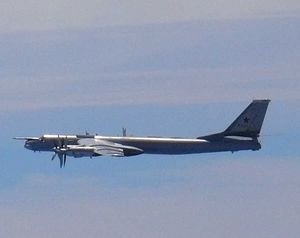South Korea and Japan had to scramble fighter jets to intercept two nuclear-capable Tupolev Tu-95MS strategic bombers and Sukhoi Su-35S (Flanker-E+) multirole fighter jets of the Russian Air Force approaching their respective air spaces on July 13.
According to the South Korean Joint Chiefs of Staff, the two Russian bombers, along with Su-35S fighter jets, spent over three hours in South Korea’s air defense identification zone (KADIZ) on July 13. Air defense identification zones are not considered sovereign or territorial airspace. (Russian bombers last entered the KADIZ in August 2017 during a joint South Korea-U.S. military exercise.)
The Republic of Korea Air Force dispatched an unknown number of KF-16C/D Block 50/52 and F-15K Slam Eagle fighters to intercept the Russian aircraft. South Korean airspace was reportedly not trespassed. The South Korean government nonetheless issued a diplomatic protest.
The South Korean Foreign Ministry summoned a senior Russian diplomat and “expressed regrets and urged the incident not to happen again,” the ministry said in a statement. “Russian military planes’ KADIZ entry will never help stabilize the Korean peninsula as well as Northeast Asia and the possibility of mid-air collision cannot be ruled out,” the South Korean Ministry of Defense (MoD) reiterated in a July 13 statement.
The Russian bombers and their fighter jet escort flew over international waters in the Pacific Ocean, the Sea of Japan and the Yellow Sea. The Russian military aircraft were shadowed by Mitsubishi F-2A fighter jets of the Japan Air Self Defense Force (JASDF) while transiting the Sea of Japan, according to a Japanese MoD statement. Japanese airspace was not violated.
The Russian bombers reportedly carried out refueling operations in mid-air. The Russian MoD called the patrol a “routine flight” and in “strict accordance with international rules of using airspace, without any violations of the borders of other countries.”
The Tu-95MS is an improved variant of the older Tu-95, a Soviet-era four-engine, long-range, turboprop, strategic bomber that can be armed with stand-off missiles such as the Kh-101/Kh-102 (nuclear variant) air-launched cruise missile or the Kh-55 subsonic air-launched cruise missile. The Russian Air Force intends to field a total of 20 Tu-95MSM bombers, an improved version of the Tu-95MS, within the next decade.
“The upgraded aircraft, along with the Tu-22M3 long-range bomber, will form the core of a new Russian heavy bomber division in Russia’s Far East to conducts patrol Pacific Ocean inside the Japan-Hawaii-Guam triangle,” I explained elsewhere. The JASDF scrambled its fighter jets 390 times in response to Russian military aircraft during Japan’s last fiscal year that ended in March. Another 500 scrambles occurred in response to People’s Liberation Army Air Force planes.
“This constitutes a decline of 41 percent for PLAAF aircraft, but a 29 percent increase of intercepts of Russian planes,” I noted back in April. “Chinese and Russian aircraft respectively accounted for 55 percent and 43 percent of total intercepts in fiscal year 2017.” The PLAAF has repeatedly sent aircraft through international airspace between the Japanese islands of Okinawa and Miyako in the East China Sea in recent months.































